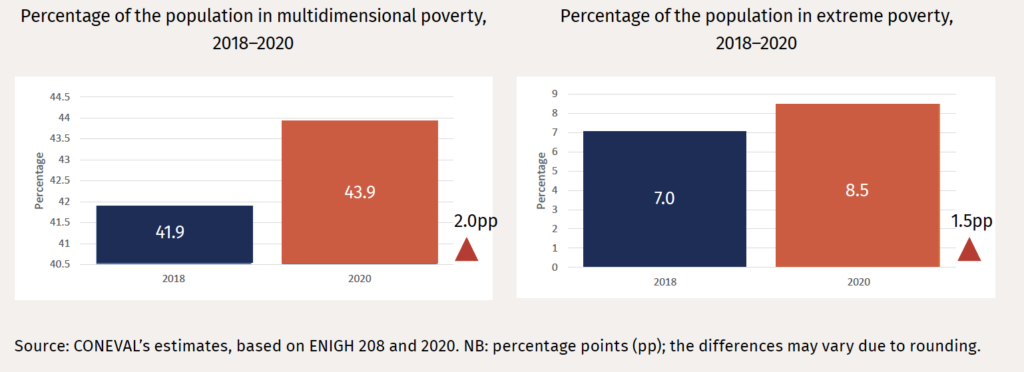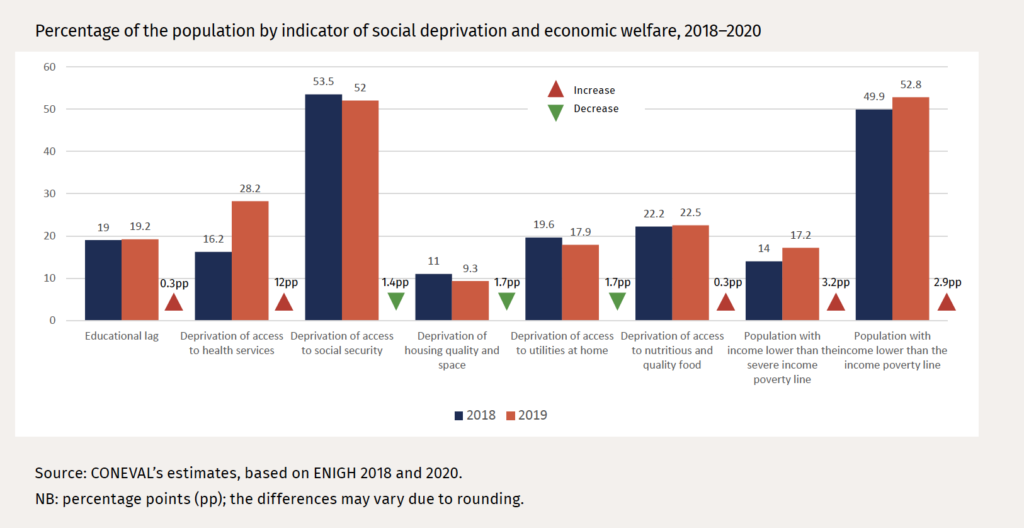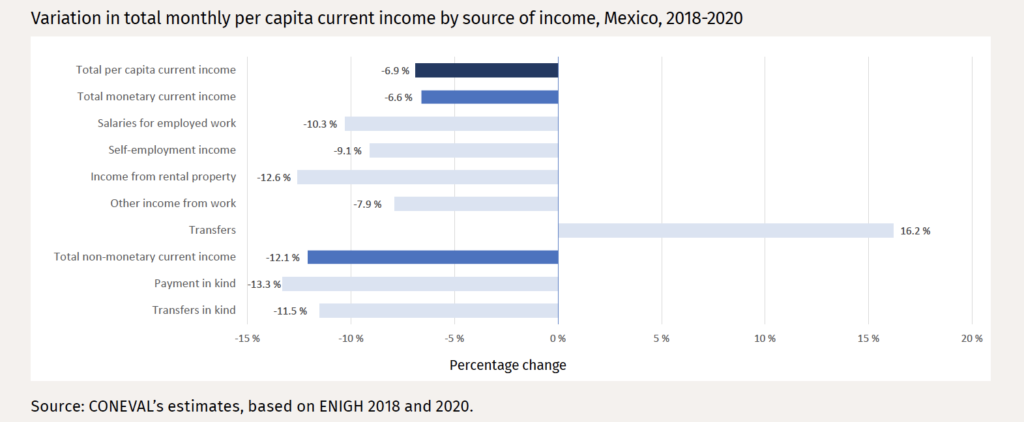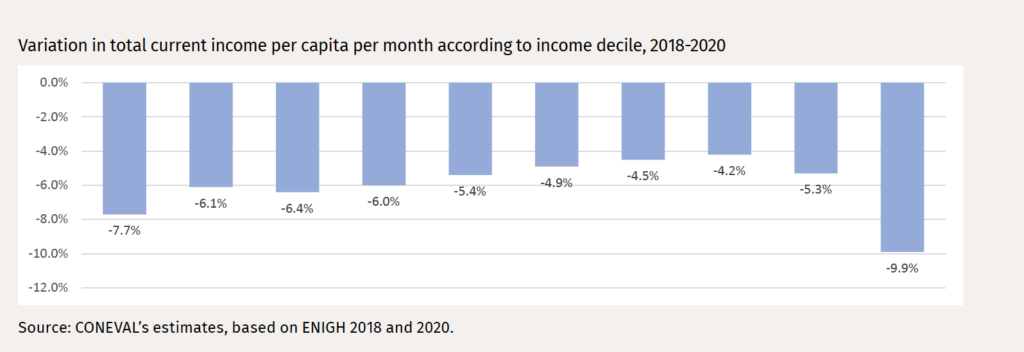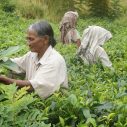
Search
Multidimensional poverty in Mexico in the context of the COVID-19 health emergency
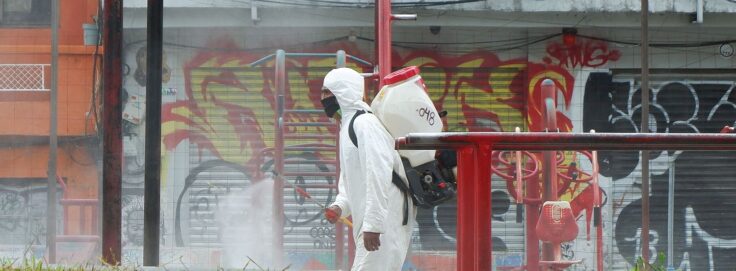
The methodology of multidimensional measurement of poverty in Mexico links two analytical spheres: economic wellbeing and social rights. The latter includes indicators of social deprivations (education lag, access to health services, access to social security, housing quality and housing spaces, access to utilities at home, and access to nutritious and quality food.)
In Mexico, the National Council for the Evaluation of Social Development Policy (CONEVAL) is the institution responsible for carrying out the multidimensional measurement of poverty based on data from the National Household Income and Expenditure Survey (ENIGH), generated by the National Institute of Statistics and Geography (INEGI). The most up-to-date data are from 2020, which provide an overview of the implications of income and social deprivations of Mexicans in the context of the COVID-19 pandemic. This article provides a summary of the main findings.
Evolution of the main indicators of poverty and social deprivations
Between 2018 and 2020, the percentage of people living in multidimensional poverty in Mexico rose from 41.9% to 43.9%, which is an increase of 3.8 million more people living in poverty (from 51.9 to 55.7 million people). Similarly, the percentage of the population living in extreme poverty went up from 7.0% to 8.5% between 2018 and 2020, representing an increase of 2.1 million more people living in extreme poverty, which rose from 8.7 to 10.8 million.
Accessing health services
During the COVID-19 pandemic, of the six deprivations considered the lack of access to health services showed the greatest increase between 2018 and 2020, going from 16.2% to 28.2% of the population, representing an increase of 15.6 million people compared to 2018. It should be mentioned that an institutional process of administrative and operational transition occurred in the health system at the same time, focusing on the people who had no social security, which involved the creation of the National Institute of Health for Wellbeing (INSABI) in early 2020, and the termination of People’s Insurance.
Economic wellbeing
In the sphere of economic wellbeing, the income of families was mainly affected by the health emergency caused by COVID-19. Against this background, between 2018 and 2020, the total current income per person per month (at 2020 prices) decreased by 6.9% at the national level.
The fall in income was reflected in the increase of the percentage of the population who had an income below the extreme income poverty line (LPEI), which went from 14.0% to 17.2% at the national level between 2018 and 2020. In other words, during this period, the number of people who were spending all their income on buying food but who were still unable to purchase the products of the food basket, rose from 17.3 to 21.9 million people.
On the other hand, the percentage of the population with an income below the income poverty line (LPI) rose from 49.9% to 52.8% between 2018 and 2020. This means that there was an increase from 61.8 to 66.9 million people who did not have sufficient money to acquire the goods and services needed to meet their needs (food and non-food).
Analysis of the source of income enables us to see the impact on employment. Between 2018 and 2020, there was a decrease of 10.3% in income derived from wages for employed work the largest category of income in Mexico, accounting for about 60.0% of wages. Likewise, income from self-employment declined by a similar amount (9.1%) during this period. In contrast, the only line of income that showed an increase at the national level was transfers, which showed an expansion of 16.2% between 2018 and 2020.
The short-term data on labour obtained through the National Employment and Occupation Survey (ENOE) by INEGI shows that between the first quarter of 2020 (before the pandemic) and the third quarter of 2020 (once the pandemic had started), there was a reduction of 4.2 million people in employment, and a 3.9% decrease in the average labour income of those who remained employed.
On the one hand, the main effects hit people who were employed informally, with 3.1 million fewer people employed, and an 8.1% drop in their average labour income. Women were also impacted: there were 2.2 million fewer women employed informally, with a 6.5% reduction in their average labour income.
Informally employed women were therefore the most affected, since, in addition to their labour income being approximately half the national average, their labour participation was further reduced, compared to their male counterparts.
When we explore the total current income per capita according to deciles of income (deciles that have been constructed by dividing the population into 10 equal parts, arranged by total current income per capita from lower to higher), it is observed that Decile I (10% of the population with lower income) experienced the second largest decrease (7.7%) between 2018 and 2020, whereas Decile X (10% of the population with the highest income) had the greatest decrease (9.9%). Although the greatest reduction in average income occurred in Decile X, it should be noted that, on average, income fell more in 50% of the population with lower incomes than in 50% of the population with higher incomes: 6.3% against 5.7%.
Based on the exercises and analysis carried out by CONEVAL, it was found in 2020 that monetary transfers from social programmes had a relevant impact by helping 4.6 million people have an income equal to or greater than the monetary value of the food basket (LPEI). (CONEVAL, 2021). This reflects the importance of social programmes for people who are poorer.
Conclusion
The multidimensional measurement of poverty in Mexico serves as a tool to identify the challenges that a social development policy must face. Based on the information collected from 2018 and 2020, it was found that the dimensions of the measurement of multidimensional poverty that had
This article was published in Dimensions 14















